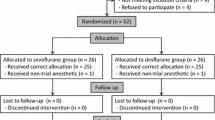Abstract
Objectives
To compare the recovery profile of sevoflurane and propofol in nasal surgical procedures.
Design
A prospective, double blind, randomized study
Setting
King Abdul Aziz University Hospital, Riyadh, Saudi Arabia, a tertiary care teaching hospital, attached with King Saud University, Riyadh Saudi Arabia.
Patients
60 ASA I–II patients age between 18–35 years, and weighing 50-80 kg, scheduled for nasal surgical procedures.
Methods
Patients were assigned randomly to one of the two groups, the Sevoflurane Group-S (n = 30) & the Propofol Group-P (n = 30). Anesthetic induction was carried out using propofol 2.0mg/kg.in both the groups. Cis-atracurium 0.15mg/kg was given for intubation. Airway was protected with a throat pack around the endo-tracheal tube. Fentanyl 1microgram/kg was given as bolus followed by infusion at a rate of 1 microgram/kg/ hour. Anesthesia was maintained with sevoflurane 2% in Group-S, and propofol infusion at a rate of 200 microgram/kg/min. in Group-P. 50% oxygen in nitrous oxide was given in both the groups. At the end of surgery, patients were extubated after reversal of the neuromuscular block. Immediate recovery was assessed by recording the time to breathe spontaneously, time to extubation, and time of spontaneous eyes movements from the time of giving reversal. Ketoprofen 1.5mg/kg intramuscularly was given to all patients before transfer to (PACU). In PACU, sedation score was assessed for 45 min. Intermediate recovery was assessed by TDT and DSST at 15, 30 and 45 min. Time taken to state name and father’s name was recorded.
Results
Patients in Group-S breathed significantly earlier than those in Group-P. Group-P showed significantly better performance with TDT at 45 min and with DSST at 30 and 45 min.
Conclusions
We conclude that both sevoflurane and propofol provide early and comparable post anesthesia recovery for patients undergoing nasal surgical procedures.
Similar content being viewed by others
References
Biebuyck, Julien F, Gouldson, Rodney, Nathanson, Michael, White, Paul F, Smith Ian (1994) Propofol: An update on its clinical use. Anesthesiology 81:1005–1043
Webster, Anthony C, Morley-Forster, Patricia K, Janzen, Victor, Watson, James, Dain, Steven L, Taves, Donald, Dantzer, Dale (1999) Anesthesia for intranasal surgery: A comparison between tracheal intubation and the flexible reinforced laryngeal mask airway. Anesthesia & Analgesia 88:421–453
Hillman DR, Platt PR, Eastwood PR (2003) The upper airway during anesthesia. British Journal of Anaesthesia 91: 31–394
Strum DP, Eger EL (1987) Partition coefficient for sevoflurane in human blood, saline and olive oil. Anesthesia & Analgesia 66:654–656
Juliana Barr, Talmage D Egan, Nancy F Sandoval, Katayoun Zomorodi, Carol Cohane, Pedro L Gambus, Steven L Shafer (2001) Propofol dosing regimens for ICU sedation based upon an integrated pharmacokinetic-pharmacodynamic model Anesthesiology 95:324–333
Gauthier, Alain Girard, Francois Boudreault, Daniel, Ruel, Monique Todorov, Alexandre (2002) Sevoflurane provides faster recovery and postoperative neurological assessment than isoflurane in long-duration neurosurgical cases. Anesthesia & Analgesia 95:1384–1388
Pensado Castineiras A, Rama Maceiras P, Molins Gauna N, Fiqueiraoure A, Vasquez Fidalgo A (2000) Immediate anesthesia recovery and psychomotor function of patient after prolonged anesthesia with desflurane, sevoflurane or isoflurane. Rev Esp Anestesiol Reanim 47(9):386–392
G Edward Morgan, Jr., Maged S. Mikhail, Michael J. Murrey (2006) Clinical pharmacology, Inhalational anesthetics in Clinical Anesthesiology 4th edition, international edition, Lange Medical books/McGraw-Hill medical publishing division, 161
Sharples A, Shaw EA, Meakin G. (1994) Recovery times following induction of anesthesia with propofol, methohexitone, enflurane or thiopentone in children. Paediatric Anaesthesia 4:101–104
Veroli P, O’kelly, B, Bertrand, F, Trouvin JH, FarinottI R, Ecoffey C (1992) Extra hepatic metabolism of propofol in man during the an hepatic phase of orthotopic liver transplantation. British Journal of Anaesthesia 68:183–186
Hughes MA, Glass PSA, Jacobs JR (1992) Context-sensitive half time in multicompartment pharmacokinetic models for intravenous anesthetic drugs. Anesthesiology 76: 334–341
Nishimori M, Takasaki M, Akune T, Hanaoka K (1998) Propofol and sevoflurane-a comparison of anesthesia for laryngo-microsurgery. Masui 47(2):168–173
Montes FR, Trillos JE, Rincon IE, Giraldo JC, Rincon JD, Vanegas MV, Charris H (2002) Comparison of total intravenous anesthesia and sevoflurane-fentanyl anesthesia for outpatient otorhinolaryngeal surgery. Journal of Clinical Anesthesia 14(5):324–328
Jellish WS, Leonetti JP, Murdoch JR, Fowles S (1995) Propofol-based anesthesia as compared with standard anesthetic techniques for middle ear surgery. Journal of Clinical Anesthesia 7(4):292–296
Loop, Torsten, Priebe, Hans-Joachim R (2000) Recovery after anesthesia remifentanil combined with propofol, desfurane, or sevoflurane for otorhinolaryngeal surgery. Anesthesia & Anagesia 91:123–129
Picard V, Dumont L, Pellegrini M (2000) Quality of recovery in children: sevoflurane versus propofol. Acta Anaesthesiol Scand 44(3):307–310
Nelskyl flurane-nitrous oxide and propofol-alfentanil-nitrous oxide anesthesia for minor gynecological surgery British Journal of Anaesthesia 1999; 83:576–57918
Juckenhofel S, Feisel C, Schmitt HJ, Biedler A (1999) TIVA with propofol-remifentanil or balanced anesthesia with sevoflurane-fentanyl in laparoscopic operations. Hemodynamic, awakening and adverse effects. Anesthetist 48(11): 807–812
Raeder J, Gupta A, Pedersen FM (1997) Recovery characteristics of sevoflurane-or propofol-based anesthesia for daycare surgery. Acta Anaesthesiol Scand 41(8):988–994
Hepaguslar H, Ozzeybek D, Ozkardesler S, Tasdogen A, Duru S, Elar Z (2004) Propofol and sevoflurane during epidural/general anesthesia: comparison of early recovery characteristics and pain relief. Middle East J Anesthesiology 7(5):819–832
Motsch J, Wandel C, Neff S, Martin E (1996) A comparative study of the use of sevoflurane and propofol in ambulatory surgery. Anaesthesist 45:S57–S62
Hong JY, Oh JI. Kim SM (2002) comparison of Sevofluranenitrous oxide and target controlled propofol with fentanyl anesthesia for hystroscopy. Yonsei Medical Journal 43(4): 420–426
Magni G, Baisi F, La Rosa I, Imperiale C, Fabbrini V, Pennacchiotti ML, Rosa G. Magni G, Baisi F et al (2005) No difference in emergence time and early cognitive function between sevoflurane-fentanyl and propofol-remifentanil in patients undergoing craniotomy for supratentorial intracranial surgery. Journal Neurosurgery Anesthesiology 17(3): 134–138
Author information
Authors and Affiliations
Corresponding author
Rights and permissions
About this article
Cite this article
Haq, A.U., Aqil, M., Rasheed, A. et al. Recovery profile of patients undergoing nasal surgical procedures: a comparison between sevoflurane and propofol. Indian J Otolaryngol Head Neck S 60, 123–127 (2008). https://doi.org/10.1007/s12070-008-0054-5
Published:
Issue Date:
DOI: https://doi.org/10.1007/s12070-008-0054-5




